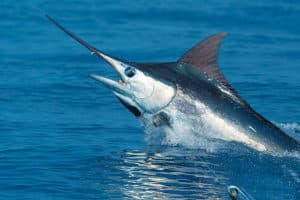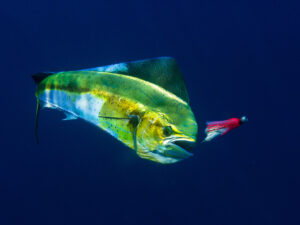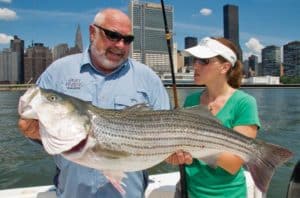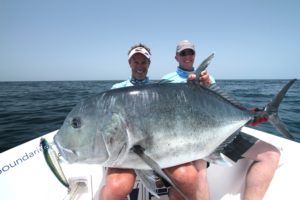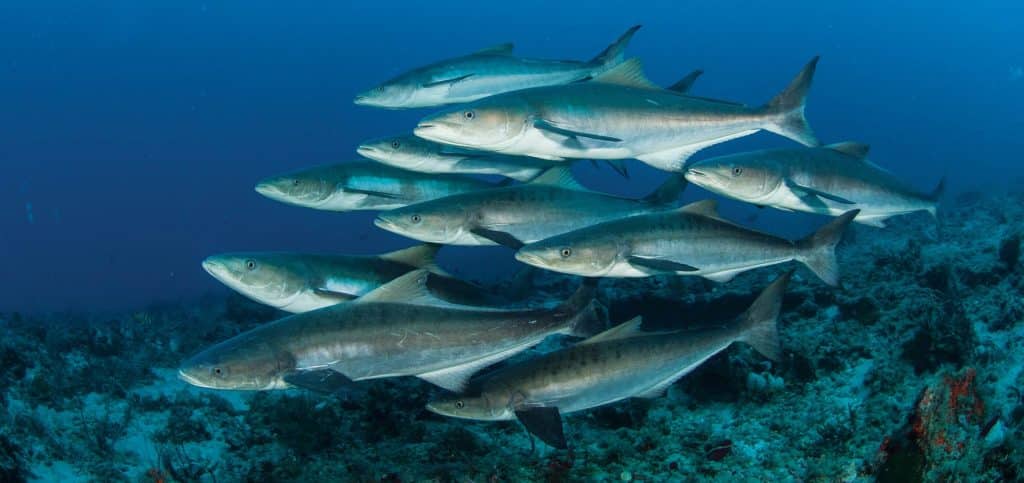
For me, a true sign of spring making the transition to summer follows on the heels of the first reports of cobia being caught off the North Carolina coast.
Sight-fishing for cobia had its genesis, at least in terms of boat design, in the northern Gulf of Mexico, where many boats bear towers and elevated casting platforms. Similarly, as the cobia sight-fishery off North Carolina has exploded in recent years, these days you’ll see many boats sporting towers and elevated platforms.
Cobia sight-fishing has become a major sport in the saltwater recreational-fishing scene along the coast of North Carolina, a sport to which many — like me — are totally addicted.
During the first half of May, North Carolina anglers normally encounter the season’s first cobia around nearshore open-Atlantic shoals. As water temperatures warm, cobia move from offshore to inshore areas. This availability makes North Carolina one of the top bets on the Atlantic Coast for spring cobia action. (Though mid-May through mid-June is a peak period, cobia continue to be targeted and caught through the summer.)
Major hot spots for spring cobia include Cape Lookout Shoals and Diamond Shoals, as well as Oregon Inlet.
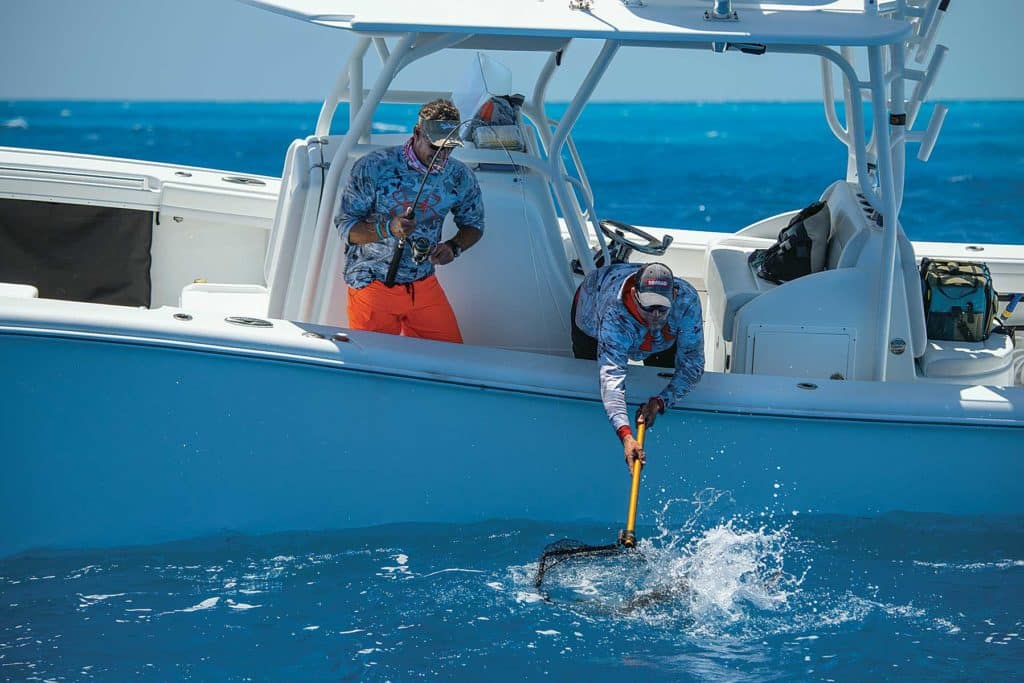
Sight-Fishing Hot Shots
Early in the season last year, I joined sight-fishing enthusiasts Carl Perry and J.T. Frazier on the charter Rock Solid (a 36 Ricky Scarborough), departing the Oregon Inlet Fishing Center at 7:30 a.m. For me — still recalling our 4:30 a.m. departures when I worked as a mate on an offshore charter boat 30-some years ago — we were uncomfortably late. However, Capt. Aaron Kelly reminded me that “there’s no use in our getting out there before the sun’s up high enough for us to see clearly enough into the water” since we were all about spotting cobia.
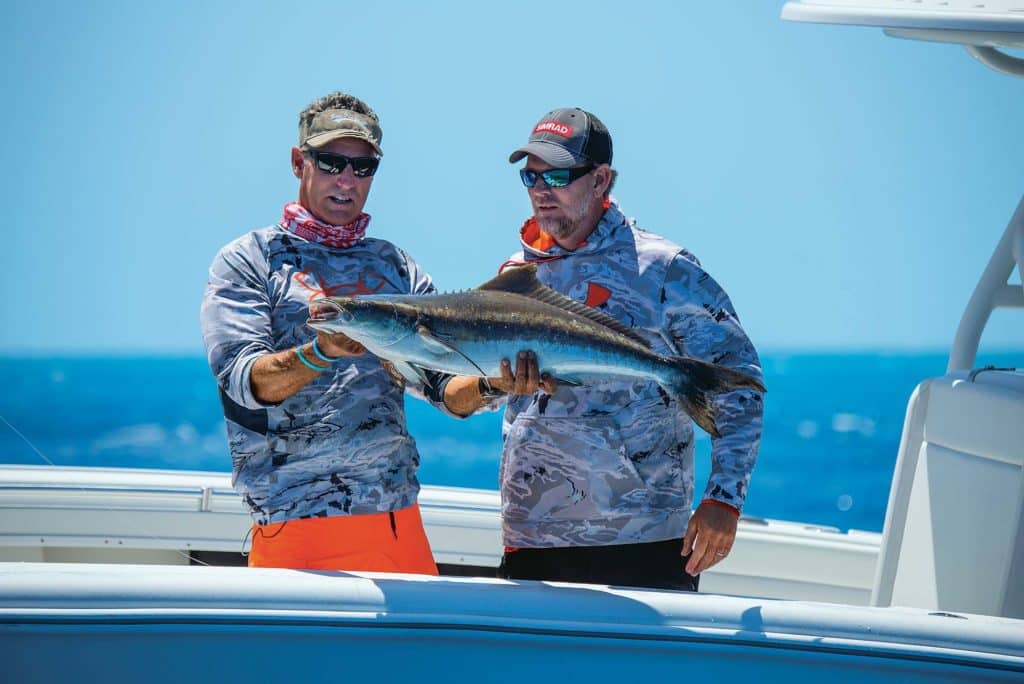
Kelly was no random or casual choice of a charter. I knew that Kelly runs one of the most accomplished cobia boats on the East Coast. At the same time, his first mate, Bob Feldhaus, is a cobia expert who has developed a line of Meat Hog jigs, extraordinarily effective bucktails for cobia.
As we cruised out the inlet, Kelly told us that yesterday they’d spotted 24 cobes but hooked only eight. “The fish weren’t turned on,” he said, as they had been earlier in the week.
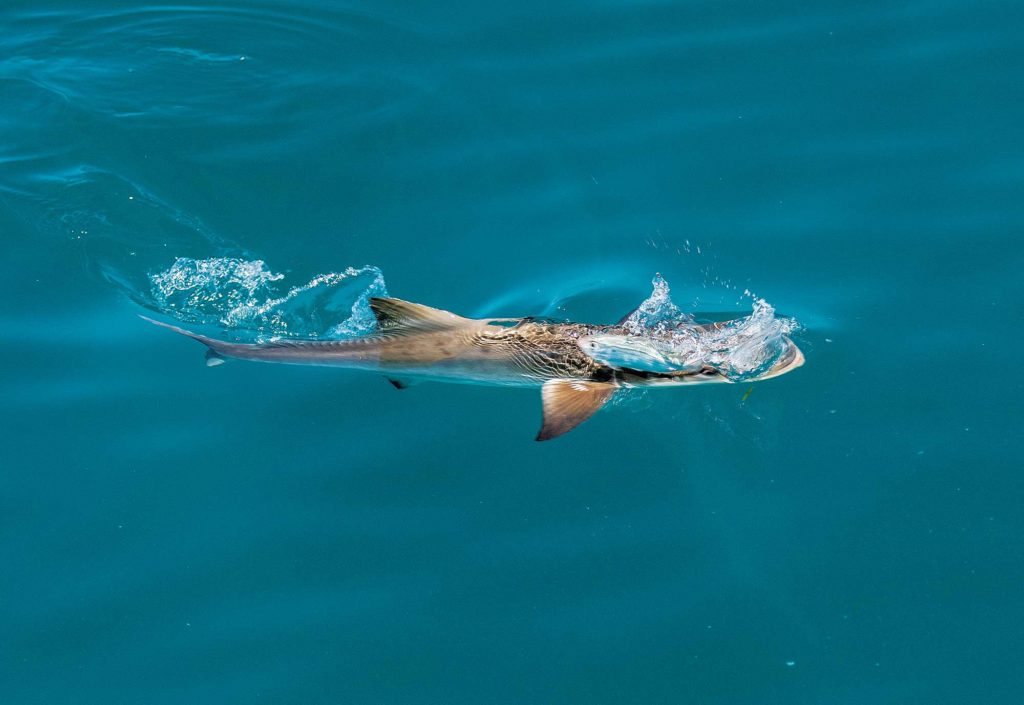
Adapt and Hook Up
Rock Solid headed toward the fourth set of inlet buoys. The sun hadn’t really materialized; we faced a 15-knot southwest wind under mostly cloudy skies — not great conditions for sight-casting.
We strained to see any cobia that might be on these navigation markers. Kelly believes these to be the best cobia attractors in the area, commenting, “I’ve made my entire day on many occasions by fishing these markers.”
However, on that morning, we found no fish on any of the markers, including the last of the markers that locals call the sea buoy.
After clearing the sea buoy, we ran south of the inlet, all three anglers in the tower trying to cover every angle of water, gazing through our polarized sunglasses and hoping to spot a cobia through the glare and chop. Kelly zigzagged from within 400 yards of the beach to a half-mile out, but we spotted no brown-backed surface swimmers.
After three fruitless hours, as we arrived off the beaches of Rodanthe, we spotted our first cobia. Unfortunately, after we made several unsuccessful casts, the fish disappeared. Not much later, we saw a pair of cobia. I managed a good cast just to their left, and the larger of the two darted out to eat the bucktail. After a brief battle, we had the 32-inch cobia unhooked and released.
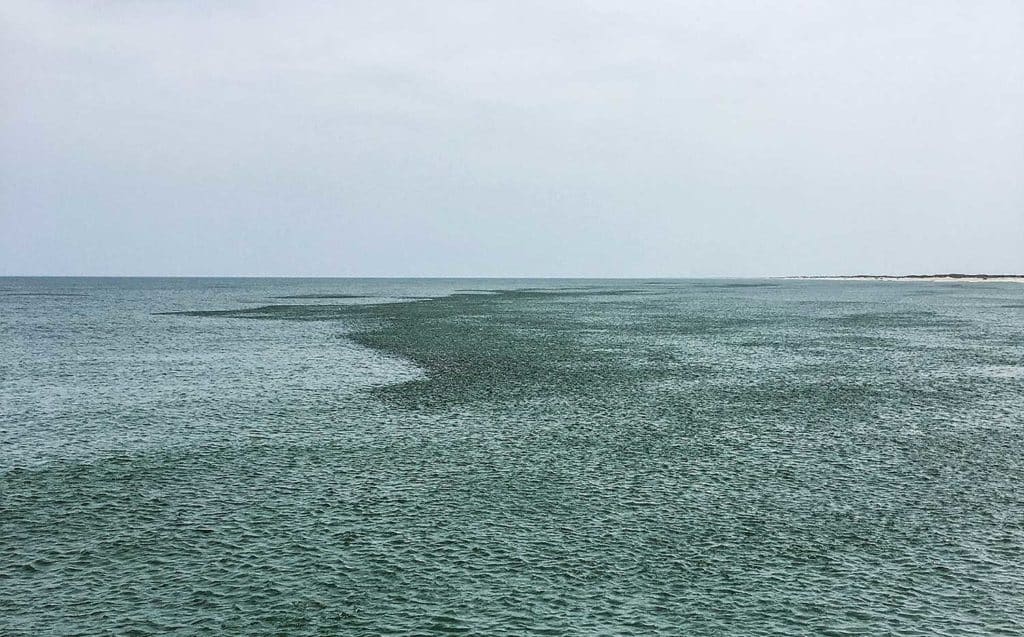
Over the next three hours, we saw another dozen cobia, in singles and pairs, and we hooked and released six, the largest of these fish at 36 inches, which is the minimum size limit for cobia in North Carolina.
By 2:30 that afternoon, a line of storms made sight-fishing impossible. We adapted quickly, changing techniques to slow-troll live menhaden that we had cast-netted earlier, rigged behind 2-ounce egg sinkers. The baits weren’t in the water for 15 minutes when both rods went down.
After the first fish came unbuttoned five minutes into the fight, we saw that the hook had broken. I continued to wrestle the other cobia. But after another 15 minutes, with the fish finally boatside, the unmistakable copper orange of a red drum appeared.
Setting the rod in the holder (as years of being a first mate had me acting instinctively), I grabbed the line, led the redfish to the boat, and lifted it carefully onto the deck. Quickly unhooking the hefty catch once we had measured the fish at 46 inches, we released it.
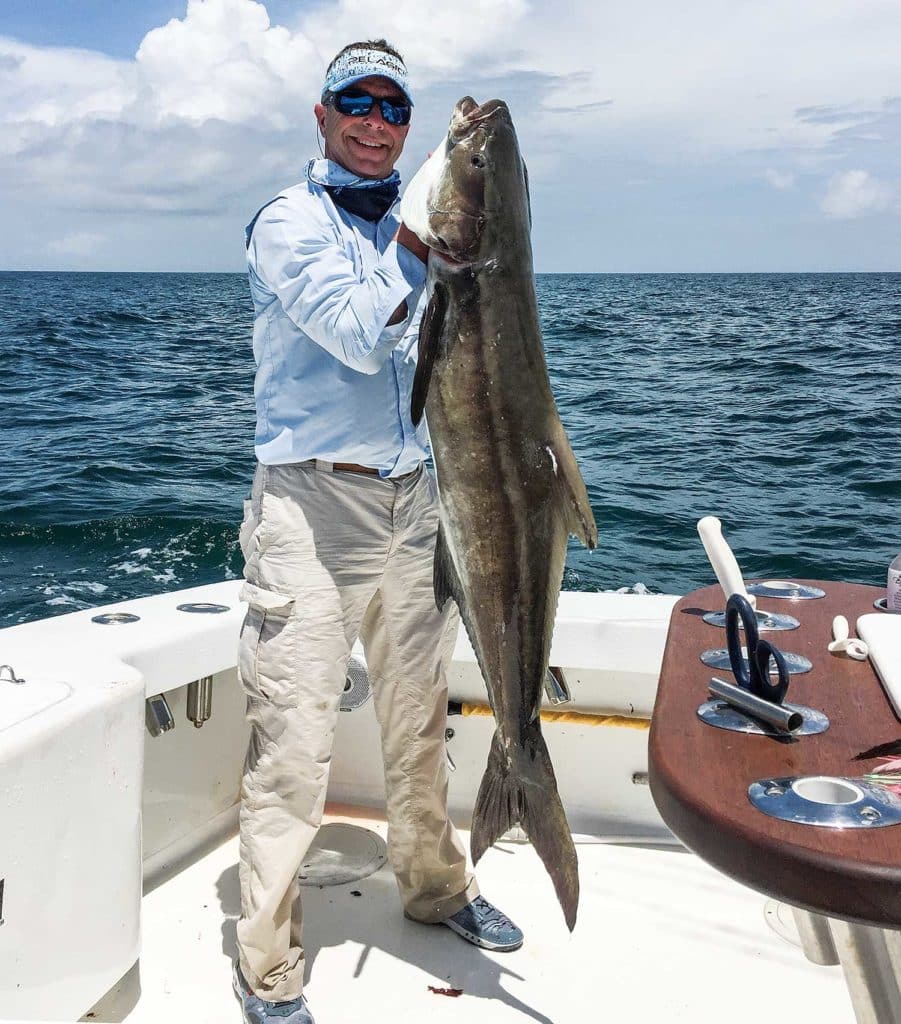
Successful First Day
By then, the storms had passed and we resumed sight-fishing. We ended up spotting three more cobia, releasing two of those, for a day’s total 17 fish sighted and nine caught and released (none quite went the legal size).
Bottom line: We had seen a good number of fish under very challenging conditions and managed a decent success rate. We were, however, puzzled as to why we saw no legal-size fish that day, and speculated that we’d caught smaller cobia that had recently made their way to waters near the beach.
Clear, sunny days with winds remaining less than 12 knots offer best conditions. On such days, I’ve seen totals as high as 70 fish spotted and up to 30 hooked and released.
Heavy-overcast windy days take sight-fishing pretty well out of the equation, but skippers still catch cobia by fishing live croakers or eels near a chum bucket on the bottom. No live bait? You can sure catch cobia on cut bait, but also expect a higher percentage of hookups from fish you don’t really want.
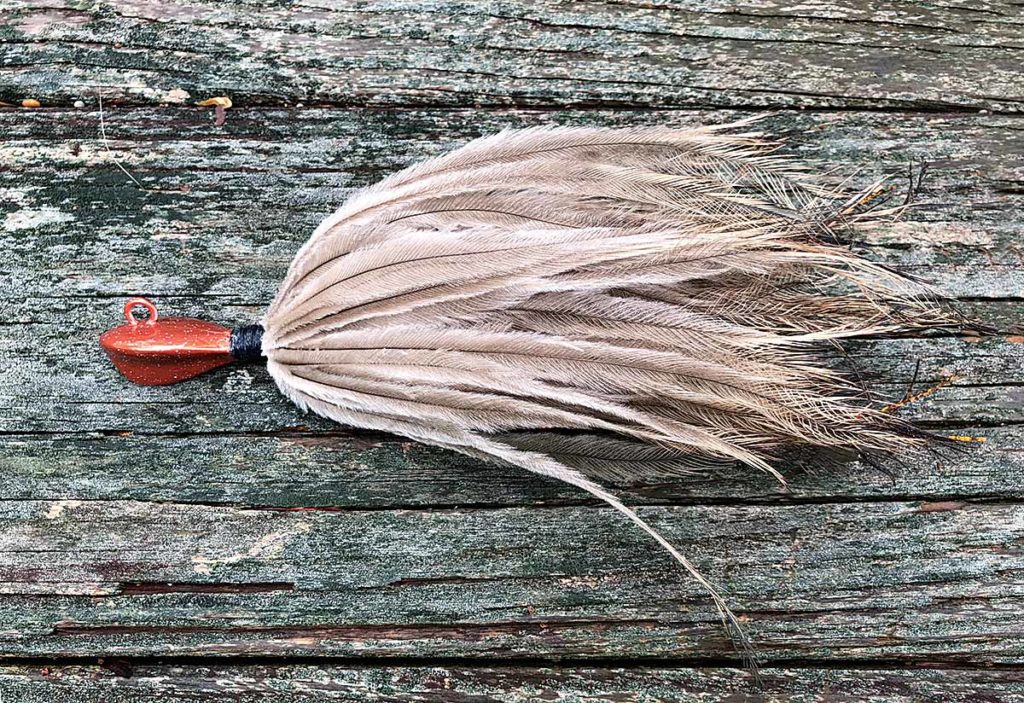
Best Tackle and Jigs
Kelly and Feldhaus have collaborated to make great advances in sight-fishing for cobia, including the development of best colors and optimal bucktail jigs, presentation techniques, and best rod-and-reel combinations for casting to and landing cobia, they have truly advanced the fishery.
From time spent with them, it seems that the best outfits for sight-fishing cobia are 8-foot spinning rods with soft-action tips for casting, and stiff butts for putting on the pressure, such as the Shimano popping-rod series. While I favor Shimano reels, in general, spinners from 8000 to 14000 size filled with 40- to 50-pound braid work well. Feldhaus adds to each rig a 4-foot section of 40- to 50-pound-test Seaguar fluorocarbon leader attached to the braid with an FG knot.
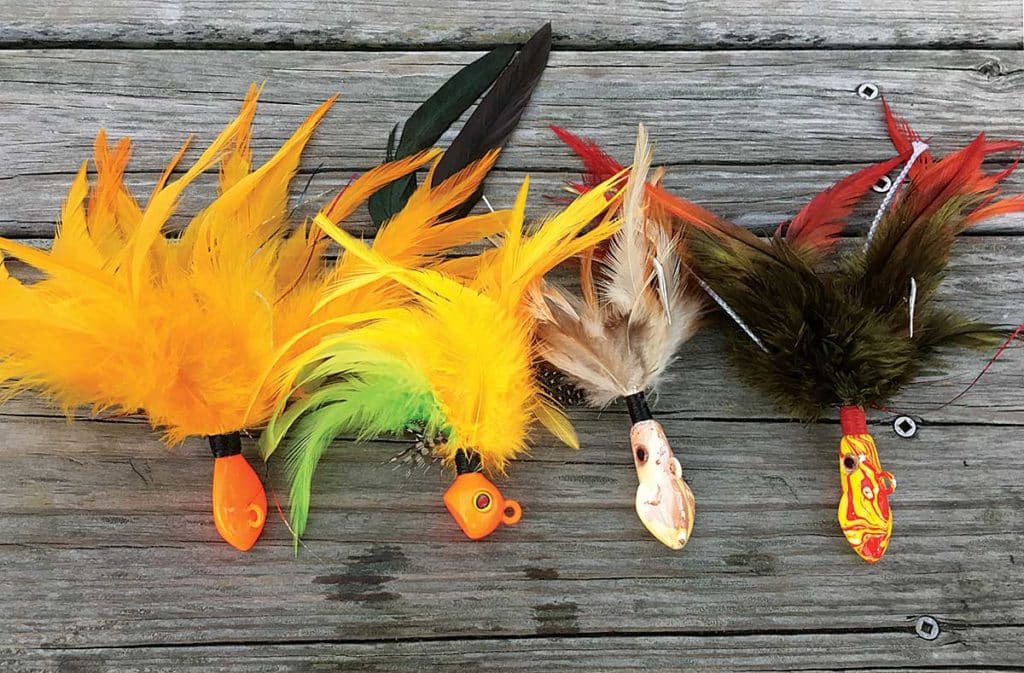
I’ve had great success with Feldhaus’ Meat Hog jigs, especially lighter-colored heads dressed with brightly colored feathers. My personal favorite is a bright-green squid-head Meat Hog jig called the Green Goblin, with bright-and-dark-green feathers and a translucent-green twister tail.
To minimize the twister tail interfering with the hook, I snip off some of the plastic body to shorten the lure so the hook comes out just ahead of where the round body flattens to the tail. While fishing with Kelly a few years ago on Diamond Shoals, I caught 98- and 96-pound cobia the same day using a Green Goblin jig. Kelly likes a Meat Hog flathead bucktail in a brownish-copper color dressed with emu feathers, which he calls the Emu Flash. He fishes this lure without a tail because “on that jig, the feathers provide the lure action.”
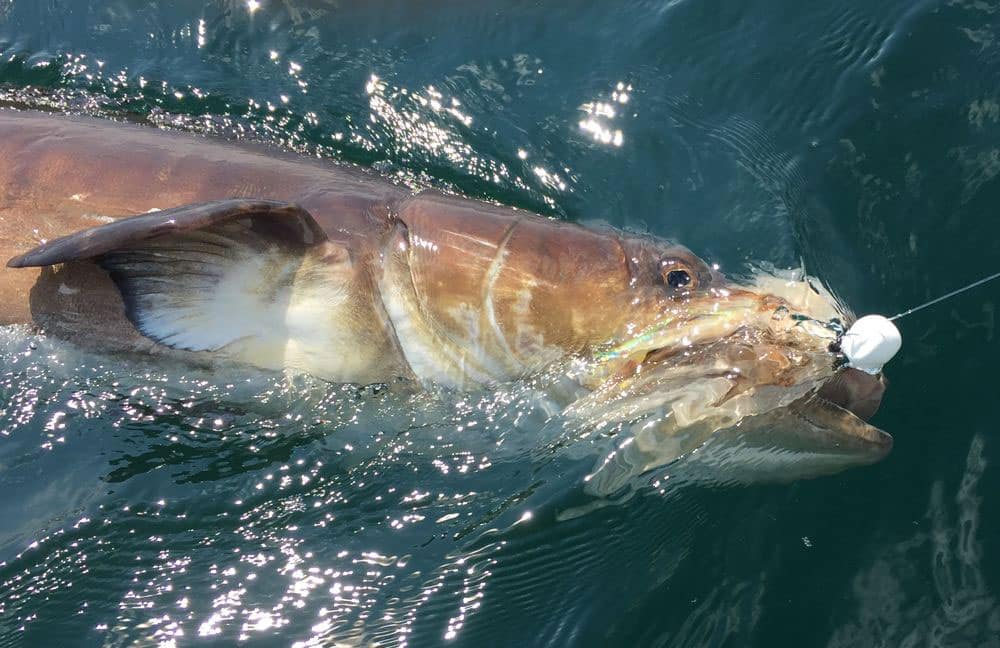
One Leatherback, a Zillion Pogies and Dozens of Cobia
That first day on Rock Solid had been successful given the somewhat-challenging conditions, but we were ready for a bang-up second session.
Unfortunately, the weather for the Oregon Inlet area the next morning was unsettled. Radar showed a line of slow-moving storms west of the strand of beaches from Rodanthe to Buxton to Hatteras Inlet.
But the captain confidently asked us, “Are you guys ready to go?”
“What about the weather?” I returned.
“You can’t catch ’em at the dock! Let’s go.” And with that, Kelly fired up the diesel engine on Rock Solid and we headed out.
Read Next: Chumming for Cobia
Sure enough, at the can buoy on the way, a cobia that looked to be in the 60-pound range nailed my bright-green Gremlin model of Meat Hog bucktail with a white plastic tail, but it came unbuttoned.
A half-hour later, heading south off the coast, we spotted a giant leatherback turtle and aimed toward it in hopes that a retinue of cobia would be in tow.
Sure enough, just as the leatherback raised its mammoth head out of the water, we saw four nice-size cobia. From the tower, we struggled to get the right angle to cast jigs in front of the fish. Perry and I both hooked up; the cobia promptly had our lines crossed and we scrambled to keep lines clear, eventually getting a pair of 40-pounders to the boat. We released both.
The weather improved, and we continued to see cobia, catching and releasing nine.
Then we came upon a school of menhaden that stretched as far as the eye could see, with bait showering here and there. We noticed areas within the acres of bait where the surface was smooth. We quickly discovered that within these calm areas, the baitfish had cleared out to make room for cobia looking for a meal.
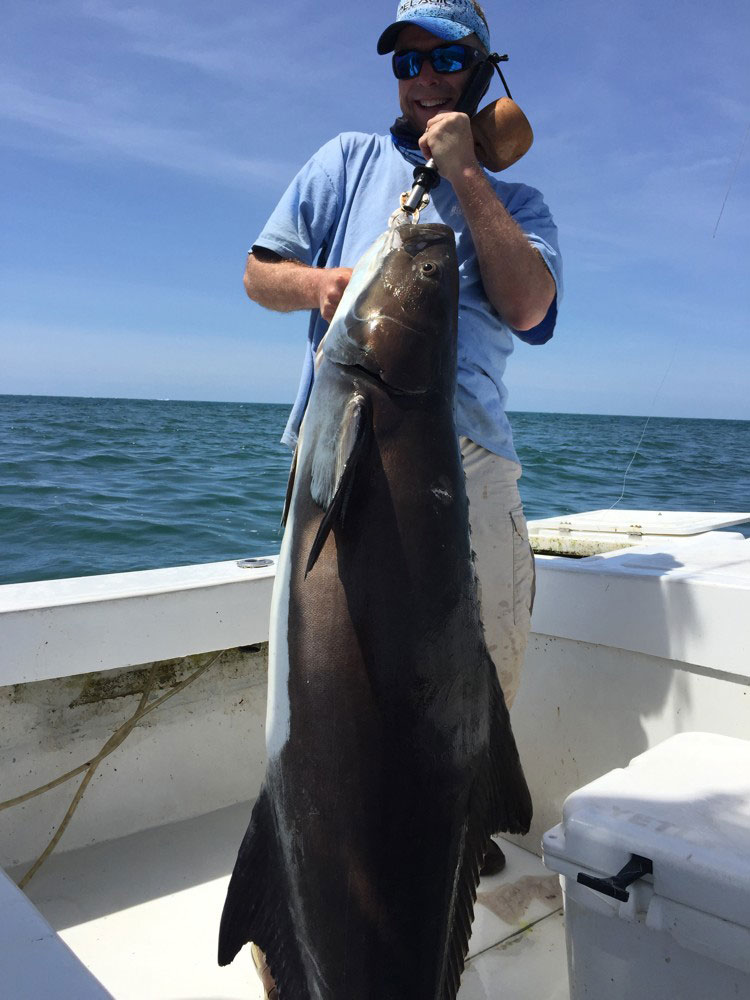
I wondered if in those circumstances, with unlimited bait all around, the cobia would eat a bucktail jig. “Well, we’re fixin’ to find out!” Kelly said with a laugh.
I cast a pink-and-white bucktail in front a big cobia sitting in the middle of tens of thousands of pogies. The fish didn’t even hesitate, eating the jig right away. Some 20 minutes later, I landed that healthy 60-pounder.
By day’s end, we had seen more than 50 cobia, catching and releasing 12 fish more than 40 pounds.
During the peak of North Carolina’s cobia season, days like this aren’t uncommon. The excitement and visual impact of sight-fishing for cobia is as good as fishing gets. Up and down the nearshore coastal waters of the state, from the Crystal Coast to the Outer Banks, sight-fishing for cobia reigns supreme in late spring and early summer.
About the Author Rob Wittman grew up working on charter boats in North Carolina and Virginia. He now represents the First Congressional District in Virginia in the United States Congress. He is chairman of the Congressional Sportsmen’s Caucus, which works on issues and legislation important to recreational fishermen.
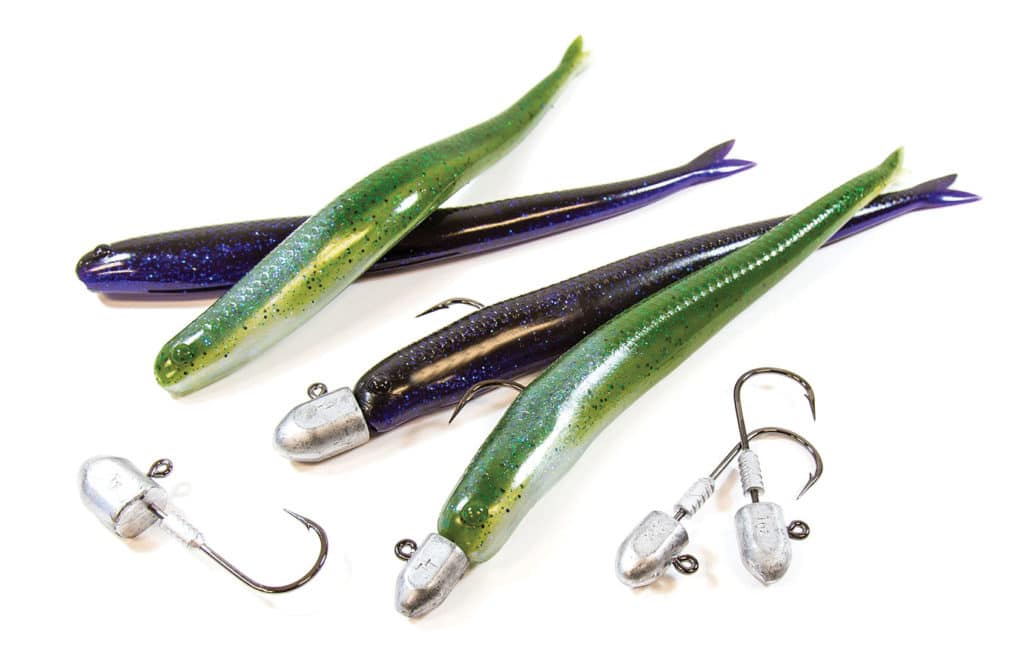
Popular Cobia Lures
In recent years, whole new lines of lures designed to target cobia have cropped up, primarily jigs, including lead-heads dressed with various types of bucktail and feathers in bright color combinations, suspending jigs and jig heads rigged with eels or swimming bodies.
Bob Feldhaus hand-makes his line of Meat Hog jigs, which he co-owns with Aaron Kelly, and they enjoy a devout following in the mid-Atlantic area. Bowed Up lures made in Kitty Hawk, North Carolina, also have a very dedicated following. Magic Tail bucktails, from New Jersey, are well-made and reliable cobia catchers. Wahoo! lures suspending bucktail jigs with a rattle chamber sink very slowly, staying in front of cobia longer than a lead-head jig. Hogy lures’ 9-inch HUDV Jigging Eel has a great action and is a proven cobia catcher. Similarly, RonZ Performance Soft Baits in the 6- and 8-inch original series do a great job of fooling cobia by imitating eels. The Elaztech Z-Man 10-inch HeroZs are nearly indestructible and so light that they fall slowly, making them great for cobia. Berkley’s Gulp! comes in a 6-inch grub that works beautifully on a bucktail jig, and its scent technology helps persuade finicky cobia.
It never hurts to have some live eels or bunker if you can get them. Many days I have found success on my second, third and fourth presentations of various offerings, as I figured out what will turn them on at that time. Always have a variety of lures and baits for cobia because their feeding moods can be different, and options simply increase your odds of success.
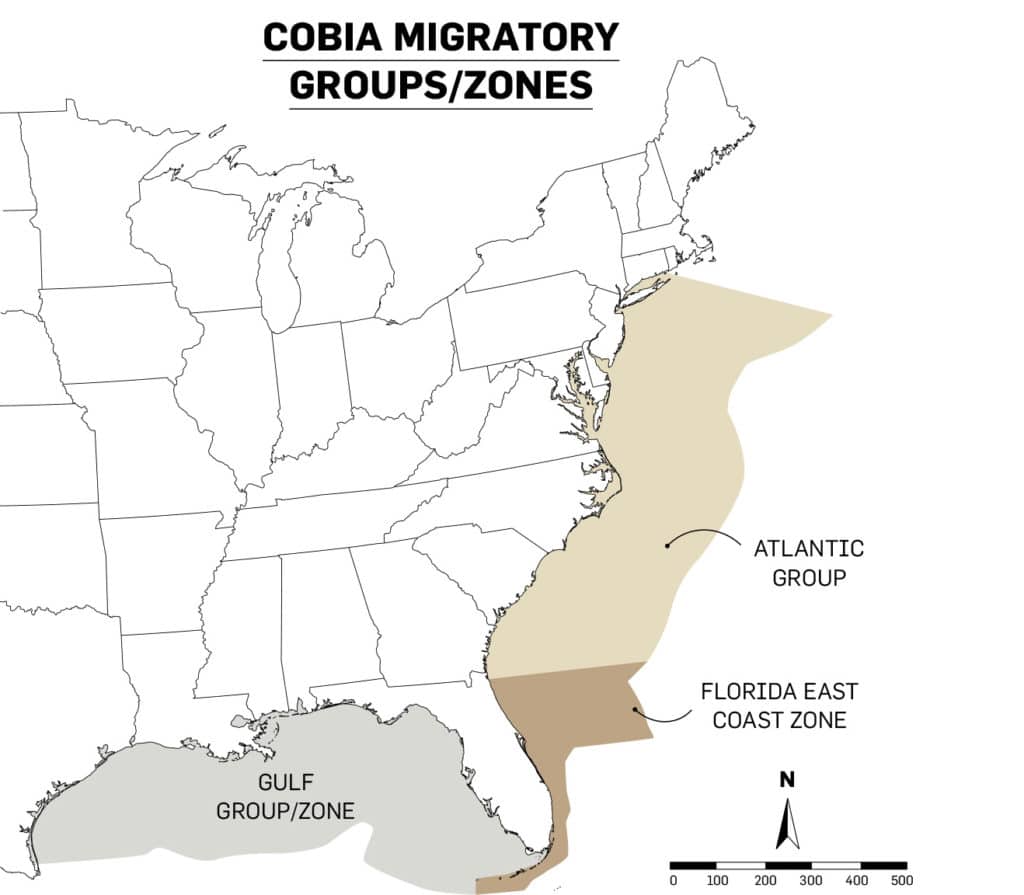
The Cobia Conundrum
Managing species that routinely cross geopolitical boundaries is one of the greatest challenges in fisheries management. In the Southeast, cobia are found in bays, estuaries and near offshore ocean waters during their annual migrations, making them subject to both state and federal regulations.
Federal fishery managers base management in the Exclusive Economic Zone (federal waters) on genetic studies that describe two distinct populations of cobia. Fish caught north of the Georgia‑Florida line along the Atlantic Coast are considered Atlantic Migratory Group Cobia, while those caught off the east coast of Florida and throughout the Gulf are part of the Gulf of Mexico Migratory Group Cobia.
In 2017, the South Atlantic Fishery Management Council closed federal waters of the Atlantic Ocean northward of the Georgia-Florida line to the harvest of cobia. This unprecedented precautionary action was taken after the 620,000-pound recreational Annual Catch Limit for AMG Cobia was exceeded by a wide margin during the two preceding years.
Recognizing that much of the harvest of AMG Cobia occurs in state waters, the SAFMC encouraged states to take measures to reduce cobia harvest. The Atlantic States Marine Fisheries Commission stepped in to coordinate state efforts through development and implementation of the Interstate Fishery Management Plan for AMG Cobia.
States from Georgia to New Jersey now have measures in place to regulate recreational harvest so as not to exceed 620,000 pounds annually, obviating the need to close federal waters during 2018. Meanwhile, the SAFMC is deliberating whether to transfer AMG Cobia management to the ASMFC.
Read Next: Cobia Bowl Aides in Virginia Cobia Fishery Research
If this happens, AMG Cobia management will be the sole responsibility of the states through ASMFC, pursuant to the Atlantic Coastal Fisheries Cooperative Management Act. No longer would AMG Cobia be managed through the Magnuson-Stevens Fishery Conservation and Management Act.
A stock-identification workshop is scheduled for 2018, during which the genetic basis for cobia management will be re-evaluated with new data. A stock assessment for AMG Cobia will begin in 2018, with final results available for managers in 2019.
The results of both will have far-reaching impacts on cobia fishing, so it is important that anglers and guides stay engaged by participating in catch-and-effort surveys, providing tissue samples for genetic analysis, serving on advisory panels, and attending public meetings.
—Capt. Spud Woodward, ASMFC commissioner — Georgia

